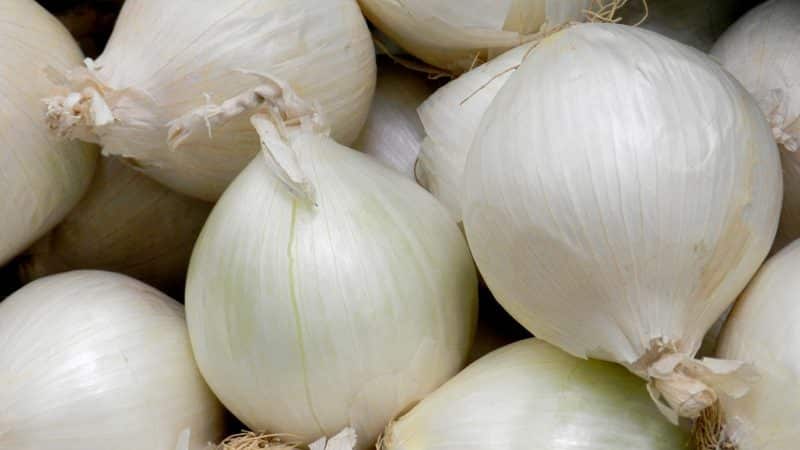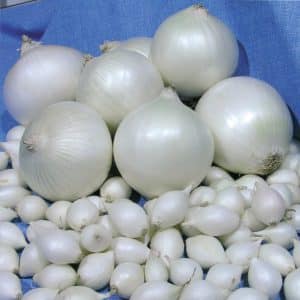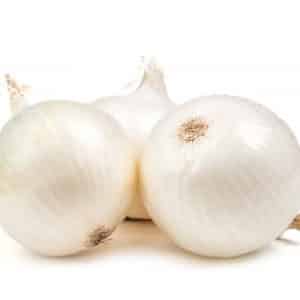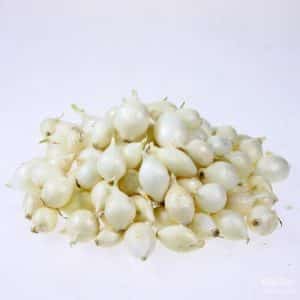An unpretentious and stable onion hybrid “Stardust” is high-yielding even with minimal care
We present to your attention a product of Dutch selection - the Stardust onion hybrid. It is grown in many farmsteads and farms, cultivated for personal use and for commercial purposes. This white onion is in demand due to its beneficial qualities used for culinary and medicinal purposes.
Description of the hybrid
Stardust F1 is a hybrid of white onions. Early ripening - onion sets and turnips are grown in one season. It can also be cultivated as a biennial: in the first year they get a large harvest of feathers, in the second year they harvest onions.
Origin and development
White onion Stardust is a hybrid bred by Dutch breeders from BEJO ZADEN B.V. It was included in the State Register of Breeding Achievements of the Russian Federation in 1999. Approved for cultivation in all regions of the country, intended for gardening.
Chemical composition, trace elements, vitamins and beneficial properties
Bulbs contain many useful substances, vitamins, and microelements. Calorie content product – 40 kcal, protein content – 1.41 g, carbohydrates – 8.1 g.
Vitamins:
- B1 – 0.05 mg;
- B2 – 0.02 mg;
- B5 – 0.11 mg;
- B6 – 0.1 mg;
- B9 – 9.1 mcg;
- C – 10.2 mg;
- E – 0.19 mg;
- RR – 0.51 mg.
Macronutrients:
- potassium – 177 mg;
- calcium – 30 mg;
- magnesium – 15 mg;
- sodium – 4.1 mg;
- sulfur – 63 mg;
- phosphorus – 57 mg;
- chlorine – 24.5 mg.
Microelements:
- aluminum – 399 mcg;
- boron – 201 mcg;
- iron – 0.81 mg;
- iodine – 3.1 mcg;
- manganese – 0.2 mg;
- copper – 89 mcg;
- fluoride – 30 mcg;
- zinc – 0.83 mg.
Stardust onion has many useful properties:
- reduces cholesterol and blood sugar levels;
- has a powerful antioxidant effect, antibacterial and antimicrobial properties;
- restores the elasticity of blood vessels;
- strengthens the immune system.
White onion juice is used in cosmetology:
- activates hair growth;
- treats acne and skin inflammation;
- cares for dry skin, preventing the appearance of wrinkles;
- eliminates brittle nails.
Ripening period
Stardust is an early-ripening hybrid; the harvest is harvested 2 months after planting the seeds or 105-130 days after sowing the seeds.
Productivity
The yield of onions when grown for greens is 2.5-2.8 kg/m2, the yield of turnips is 3.5-5.2 kg/m2.
Disease resistance
The variety is characterized by stable immunity to many crop diseases: powdery mildew, gray rot. Not susceptible to invasion pestsparasitic in the soil.
Characteristics of the bulb, description of appearance, taste
The rosette variety is erect, voluminous. The leaves are tall, strong, narrow, rich green in color with a slight waxy coating. The bulb is white, round, medium size. The weight of the head is 45-65 g. The scales are dry, do not fit tightly together, and are easily separated when cleaning. The taste is sweetish, semi-sharp, mild.
For which regions is it best suited and what are the climate requirements?
Stardust onions are approved for cultivation in all regions of the country. In northern regions with severe frosts, the hybrid can be cultivated in greenhouse conditions.
The main advantages and disadvantages of a hybrid
The hybrid has many advantages:
- high performance;
- high-quality strong feathers;
- excellent taste characteristics;
- high immunity to diseases and pests;
- versatility in use.
The disadvantage of the hybrid is the need to purchase seed material annually.
What is the difference from others
Unlike other varieties, Stardust onions are grown in 1 season, first producing onion sets, then turnips.
Features of planting and growing

The hybrid is grown in two ways: from seeds or sets. When grown from seeds, planting material is first germinated and then planted in open ground.
To grow onions, choose a sunny area. The soil on the site should have neutral acidity, it should be cleared of plant residues. The site is prepared in the fall by digging it up with organic fertilizers. Use dry chicken manure - 200 g per 1 m².
Preparing for landing
Before sowing, the seeds are prepared. First, they are filled with warm water for 2-3 hours. Empty seeds that float up are discarded, the rest are disinfected. To do this, they are placed in a bag made of several layers of gauze, soaked in a pink solution of potassium permanganate for 30-40 minutes, and washed with clean water.
To obtain simultaneous germination, the seeds are soaked in water heated to 40°C for 30-40 minutes.
In order to strengthen the immune system, hardening is carried out: a bag of seeds is placed in the refrigerator for 20-25 minutes.
Then the seed material is germinated. To do this, lay it out on a damp cloth.
and cover with several layers of gauze, which is periodically moistened. Sprouted seeds are planted in the ground and watered regularly until shoots appear.
Soil requirements
The taste of onions is affected by the composition of the soil.
Reference. In loamy soil, the taste of vegetables will be strong.
The culture responds well to black soil and sandy loam soils.In heavy, clayey soil, the crop will produce sparse shoots.
The site is being prepared in the fall. When digging up the ground, add wood ash, humus, ammonium nitrate (25 g/m²), superphosphate (15 g/m²), potassium nitrate (20 g/m²). When grown in soil with a predominance of peat, the amount of superphosphate is doubled.
Dates, scheme and rules of planting
The hybrid is grown in one season. Two methods are used: seedlings are grown or sown in open ground in early spring.
Seedling method
Sowing of seeds is carried out at the end of February in warm rooms in large containers filled with fertilized soil mixture. Make grooves 1.5-2 cm deep, the distance between the grooves is 20-25 cm. The soil is moistened with water, the seeds are laid out 1-1.5 cm apart, sprinkled with earth and lightly compacted.
After 2 months, the finished seedlings are planted in open ground. This is done at the end of April - beginning of May, when the soil warms up to +10..+12°C. In a pre-prepared area, make grooves 5-6 cm deep, leaving 25-28 cm between rows. The seedlings are watered with a humate solution every other day.
Seed method
Seeds are sown in early May. The beds are pre-covered with film to warm the soil. Before planting, the furrows are watered with hot water. The seeds are planted to a depth of 2-3 cm at a distance of 5-7 cm, 20-25 cm are left between the rows. The seeds are covered with a thin layer of soil. The emerging seedlings are thinned out, leaving a distance of 10 cm.
Features of cultivation
Planting in open ground is carried out only after the soil has warmed up to +10...+13°C at a depth of 20 cm.
Before the first shoots appear, the soil is covered with a transparent film, creating a greenhouse effect. When condensation appears, the film is lifted and ventilated.
Nuances of care
When growing crops for seedlings, special attention is paid to additional lighting. Young seedlings need lighting for 12 hours.
To prevent feathers from becoming brittle, pinching is done after three feathers have formed. Leaves are shortened by 2/3 of their length.
To develop immunity to adverse weather conditions in a crop, hardening is carried out. A week before planting in open ground, the plants are exposed to the open air, first for half an hour, then the hardening time is increased daily.
Watering mode
Water as the top layer of soil dries.
Important! With insufficient watering, seed germination will be low, and excessive watering will lead to the development of fungal infections.
After planting, water the onions once a week. In persistent hot weather, the frequency of watering is increased to 2 times a week. With each watering, 6-8 liters of water are consumed per 1 m². Starting in July, during the period of turnip growth, watering is stopped. At high air temperatures, it is allowed to moisten the soil every 8-10 days.
Loosening the soil and weeding
After each watering, the beds are loosened: the formation of a soil crust should not be allowed. Loosening is carried out carefully so as not to damage the head.
Weed out weeds as they appear. Weeds grow quickly, drawing moisture and beneficial microelements from the soil - this slows down the growth of the crop.
Top dressing
7 days after emergence, the first fertilizing is carried out using the following composition: 10 g of urea, 10 g of potassium nitrate, 25 g of superphosphate per 10 liters of water.
After 2 weeks, the seedlings are fed with organic matter: dry chicken manure diluted in a bucket of water (1:10) or cow manure mixed in water in a ratio of 1:5.
A month after the second feeding, the fertilizers necessary for the growth of the turnip are applied.To do this, use complex products containing phosphorus and potassium: 25 g of potassium monophosphate per 10 liters of water. From organic matter, wood ash is used (a glass of ash per bucket of water).
Disease and pest control
Under unfavorable growing conditions, downy mildew (downy mildew) may appear on the crop.: a whitish coating appears on the feathers, first the feathers wither, then the disease spreads to the onion head. When growing turnip crops, treatment with a 1% solution of Bordeaux mixture is used.
Attention! When growing crops for greens, the use of chemicals is not allowed.
For prevention illnesses Potassium-phosphorus fertilizers are applied to the soil.
Bacteriosis is a fungal infection that occurs during storage of vegetables. The bulbs soften and emit a putrid odor. Rotten layers are visible on the cut of the head. To prevent bacteriosis, three weeks before harvesting, plants are treated with a 1% solution of copper sulfate.
White rot may appear on vegetables – a fungal disease in which the scales soften and a white coating in the form of cotton wool appears on it. The disease develops with excessive moisture, excessive application of nitrogen to the soil, and increased soil acidity. At the first signs of damage, plants are sprayed with Sumilex.
Insect pests may appear on the crop:
- Onion fly lays larvae in onion feathers. The larvae feed on the green mass of the plant, the feathers dry out, and the heads begin to rot. For prevention, the beds are sprinkled with wood ash and treated with a solution of table salt: 250 g of salt per 10 liters of water.
- Onion thrips lays eggs on young shoots. Onion feathers affected by thrips change color and dry out.For prevention and pest control, the beds are sprinkled with ash and tobacco.
Harvest and storage

Harvesting begins in late September - mid-October. At this time, the neck of the head dries out, the feathers lie on the beds. If frost is approaching, the ripening process of the bulbs is accelerated by digging in each head with a pitchfork, slightly opening it from the ground.
After harvesting, the bulbs are sorted. Specimens with undried necks are sent for processing. The feathers of the selected onions are cut off, the vegetables are laid out to dry in a dry room for 5-7 days, then transferred to vegetable storage.
How and when to collect
When all the feathers are bent towards the ground, the collection begins. To do this, choose a sunny day. Vegetables are dug up with a pitchfork, cleared of any remaining soil, and laid out to dry.
Store the harvest recommended in nets or boxes with side openings to provide air access.
Storage features and shelf life of the hybrid
In the room where the crop is stored, create a microclimate with temperature air +1...+3°С and humidity 60-75%. There must be constant air circulation in the storage room. It is recommended to stir the onion heads periodically.
Under the right conditions, the crop is stored until the next season. The keeping quality of the hybrid reaches 96%.
What difficulties may there be when growing
When growing a hybrid, keep in mind that if there is insufficient watering, the bulbs will become bitter. With excessive watering, the turnip begins to rot.
Watering is carried out only along the furrows. Irrigation by sprinkling is not allowed, as this may cause downy mildew to appear on the plants.
Advice from experienced gardeners
Experienced gardeners recommend:
- follow the rules of crop rotation, the best predecessors are cucumbers, zucchini, cabbage, tomatoes, pumpkin, legumes;
- grow white onion sets Stardust f1 on raised beds - such beds warm up better;
- shorten the roots by 1/3 when planting - with long, upward-curved roots, the survival rate of plants decreases.
Reviews of the onion hybrid Stardust
Consumers note the mild, mild taste of onions.
Elena, Lyuban: «I grow white Stardust onions into heads. The bulbs grow small. I really like the taste, I add it to all vegetable salads.”
Ivan, Astrakhan: “I plant a small plot of Stardust onions every year. My wife likes the semi-sharp taste of onions. They are especially good for decorating salads on top. We didn’t keep it for very long, until the New Year.”
Oleg, Rostov: “I planted different varieties, read the description and reviews about Stardust onions - I decided to plant them. I tried it with seeds and sevka. I'm pleased with the result in both cases. At the beginning of summer, you can already pick green feathers. I collect turnips in the fall. I like the sweet taste, the heads are not spicy, juicy.”
Conclusion
Stardust onions are popular among farmers and amateur gardeners. Its main advantages are its unpretentiousness, ease of cultivation, and excellent taste. The hybrid is available for cultivation in all regions of the country and is used in cooking and cosmetology.